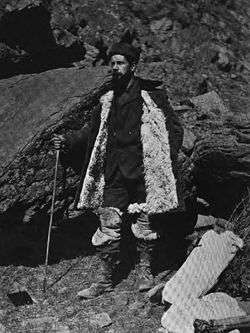Frank Nicholas Meyer
| Frank Nicholas Meyer | |
|---|---|
|
Frank N Meyer circa 1909 | |
| Born |
Frans Nicolaas Meijer 30 November 1875 Amsterdam, Netherlands |
| Died |
2 June 1918 (aged 42) near Shanghai, China |
| Cause of death | Drowning |
| Occupation | Botanical exploration |
| Employer | United States Department of Agriculture |
Frank Nicholas Meyer (1875–1918) was a United States Department of Agriculture explorer who traveled to Asia to collect new plant species. He introduced 2,500 plants into the United States. The Meyer lemon was named in his honor.[1]
Biography
He was born Frans Nicolaas Meijer in Amsterdam in 1875. For seven years Meijer was educated at the Hortus Botanicus in Amsterdam as an assistant of Hugo de Vries.[2] He emigrated to the United States in 1901 and became an American citizen in November 1908 adopting the name "Frank N. Meyer". In 1901 he first went to work for Erwin F. Smith at the United States Department of Agriculture. In 1902, Meyer began working at USDA's Plant Introduction Station in Santa Ana, California.[3] Meyer was hired in 1905 by the USDA in their Office of Seed and Plant Introduction to send back to the United States economically useful plants. Through an arrangement with Charles Sprague Sargent and David Fairchild Meyer was also to send to the Arnold Arboretum trees and shrubs of ornamental value. They archived images he collected of his travels.[4]
Specimens he collected included apricots, soybeans, and ginkgo biloba.[5]
In June 1918 he traveled to Shanghai over the Yangtze River on the Japanese riverboat Feng Yang Maru. He was last seen leaving his cabin on June 1, at 11:20 pm. On June 5 his body was found some 50 km before the city of Wuhu by a Chinese sailor. He was buried in Shanghai on June 12 and his family in the Netherlands were notified of his death on June 18.[2]
Works
- Meyer, Frank Nicholas and David Fairchild. South China explorations. Typescript, July 25, 1916 – September 21, 1918.
Legacy
In recognition of his industry, the Frank N. Meyer Medal for Plant Genetic Resources was struck by his United States Department of Agriculture colleagues, funded by his bequest to the organization.[6]
References
- ↑ "The Meyer Lemon: More Than A Pretty Face". National Public Radio. 18 February 2009. Retrieved 2009-02-20.
In the early 1900s, the U.S. Department of Agriculture sent Frank N. Meyer, an agricultural explorer ... on several trips to Asia with the mission of collecting new plant species. Among more than 2,500 plants that he introduced to the U.S., the Meyer lemon was named in his honor. Sadly, Meyer would never live to see the success of his namesake. He died on an expedition near Shanghai in 1918. ...
- 1 2 Peter Zwaal, Frans Nicolaas Meijer (Frank N. Meyer), plantenjager in Centraal en Oost-Azië, 2014 (Dutch)
- ↑ "Frank N. Meyer (1875-1918)". Special Collections, National Agricultural Library. Retrieved 2014-05-25.
- ↑ "Botanical and Cultural Images of Eastern Asia, 1907-1927". Harvard University. Retrieved 2009-02-20.
Frank Meyer, born Frans Meijer in Amsterdam, began his horticultural career at age 14 working as a gardener's helper at the Amsterdam Botanical Garden. ... At age 22, Meyer set out for America by way of England and arrived in the United States in late 1901. ... After a year with the USDA, Meyer went to Mexico to study and collect plants. Upon Meyer's return in 1904, David Fairchild (1869-1954), Chairman of the Foreign Plant Introduction Section of the USDA, hired Meyer to make a collecting trip to China for the department. ...
- ↑ "When life gives you lemons, grow a beard". Prologue: Pieces of History. 2011-06-10. Retrieved 2014-05-25.
- ↑ Explorers: Frank Nicholas Meyer Botanical and Cultural Images, 1907-1927.
- Cunningham, Isabel Shipley (1984). Frank N. Meyer, plant hunter in Asia (1st ed.). Ames: Iowa State University Press. ISBN 0813811481.
- Fairchild, David. An Agricultural Explorer in Asia. Asia; the American Magazine on the Orient. January, 1921.
External links
- Botanical and Cultural Images of Eastern Asia, 1907-1927 at Harvard
- "Guide to the Frank N. Meyer (1875 -1918), papers" (PDF). Archives of the Arnold Arboretum of Harvard University. Retrieved 2014-05-25.
